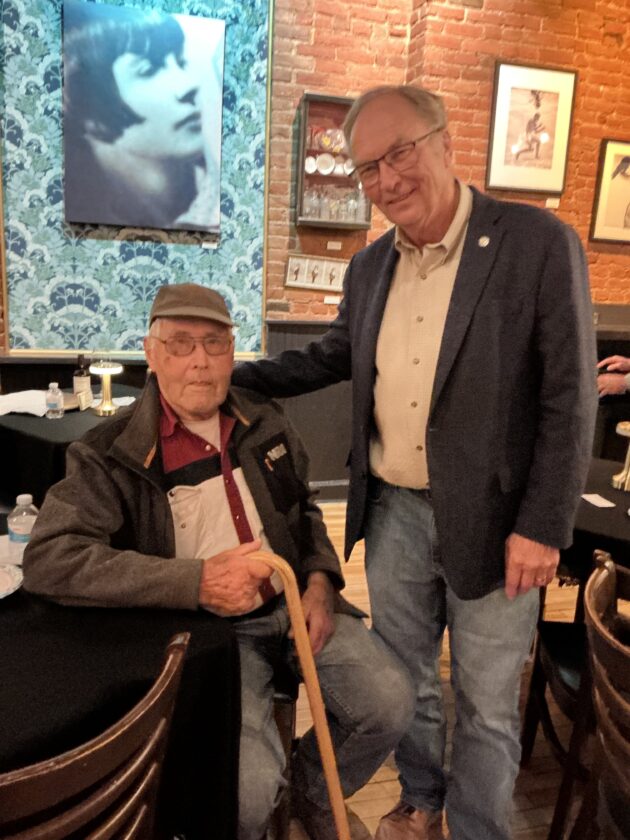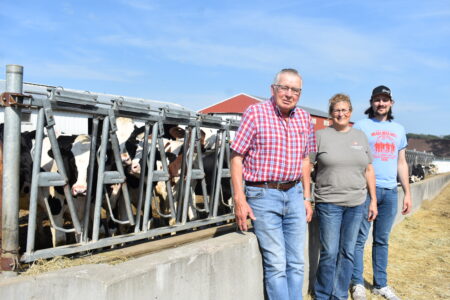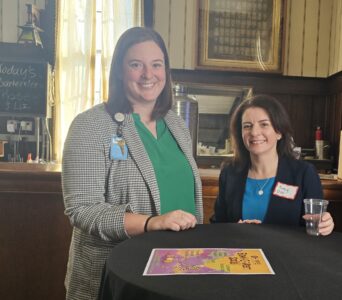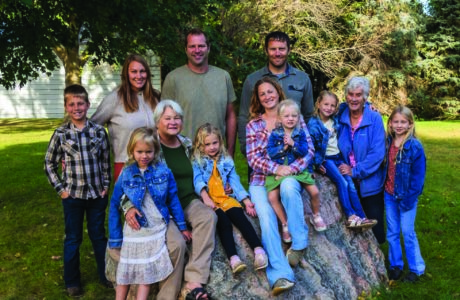‘Darby’s Miracle’ focuses on the love of the river
Community gathers to celebrate Minnesota River progress and chart future course

Harley Vogel, 94, shares his observations about changes to Lac qui Parle with State Representative Paul Torkelson during Thursday’s “For Love of a River Revival” event at the Grand Center for Arts and Culture in New Ulm.
NEW ULM — A crowd filled the Grand Center for Arts and Culture in downtown New Ulm Thursday night for “For Love of a River Revival,” an evening of music, film and discussion focused on the Minnesota River and ongoing efforts to restore and protect it.
Organized by the Coalition for a Clean Minnesota River, the event featured the launch of the book “For Love of a River” by the late Darby Nelson, a screening of the 2011 documentary “River Revival,” and a panel discussion on water storage solutions and the proposed Minnesota River Coordinating Commission.
Geri Nelson and editor John Hickman opened the evening with a presentation of Darby Nelson’s book, which chronicles paddling journeys down the Minnesota River from Browns Valley to its confluence with the Mississippi. Nelson, an aquatic ecologist who grew up in Morton, completed the manuscript before Alzheimer’s disease prevented him from editing it.
“We finished the manuscript, but his Alzheimer’s had gotten to the point where he couldn’t edit,” Geri Nelson said. “John told us, ‘I can do whatever you ask.’ It was so hard for Darby to let someone else take over.” She added, “We call it Darby’s miracle. It was amazing we were able to get it all done.”
Hickman, who also co-directed the documentary, reflected on Nelson’s legacy.
“Darby had a gift for connecting science with story,” he said. “Editing the book was about honoring that voice and making sure it reached the people who care about this river.”
The book’s release coincided with Nelson’s 60th high school reunion in Morton, adding a personal milestone to the project. Proceeds from book sales support restoration efforts led by the Coalition.
Attendees then viewed “River Revival,” a documentary created by Jon Carlson and Hickman that premiered in 2011 on KARE-TV. Narrated by Ron Schara with a soundtrack by Scott Sparlin, the film highlights decades of collaborative conservation work across the 37-county Minnesota River basin.
Sparlin, a longtime river advocate and performer at the Children’s Water Festival, also performed two original songs during the event: “Come on Down to the River” and “Let’s Clean It Up.” Audience members joined in the final chorus: “Clean it up, clean it up, clean it up.”
The program concluded with a panel discussion featuring Sparlin, Rita Weaver of the Minnesota Board of Water and Soil Resources, and Drew Campbell, former Blue Earth County commissioner.
Weaver emphasized the role of soil health in water storage. “Most people think of wetlands or big basins, but the big one people miss is the storage in the soil,” she said. “Soil health practices put more water in the ground.”
She added that sediment in the river often comes from eroding banks and bluffs, not just agricultural fields.
“When we model watersheds, what we’re really modeling is the water coming off the landscape,” Weaver said.
Campbell spoke about the challenges of building political momentum for watershed restoration.
“Everybody wants cleaner water, but there’s not a political will,” he said. “Some folks are just afraid of any kind of change, even beneficial change.”
Among the attendees was 94 year-old Harley Vogel, who shared observations about changes at Lac qui Parle.
“I’ve seen springs disappear,” Vogel said. “You wouldn’t believe how dry that crop ground is now, because the springs are gone.”
State Rep. Paul Torkelson also attended, signaling bipartisan support for Minnesota River conservation efforts.
“Over my time in the legislature, I’ve done quite a bit of work on water quality,” Torkelson said. “The buffer law was controversial, but compliance has been very high. Not everybody likes buffers, but they’ve shown their worth.”
“The river is getting better. We’re getting smarter about water management. Farming practices have improved,” Torkelson said. “But we still have problems to solve.”
Sparlin announced that the Coalition is pursuing the establishment of a state-level Minnesota River Coordinating Commission, modeled after similar boards for the Mississippi headwaters and Red River.
“We’ve gleaned from 17 Minnesota River Congresses,” he said. “We feel the state should have a role in managing the basin.”
“I’ve talked with legislators in both political arenas,” Sparlin said. “We’re on the road to potential, but the devil’s always in the details.”
The evening closed with a call to action, emphasizing that improved water quality requires continued collaboration among farmers, urban residents and policymakers throughout the watershed. Books were available for purchase for $20, with all proceeds supporting restoration efforts led by the Coalition for a Clean Minnesota River.





